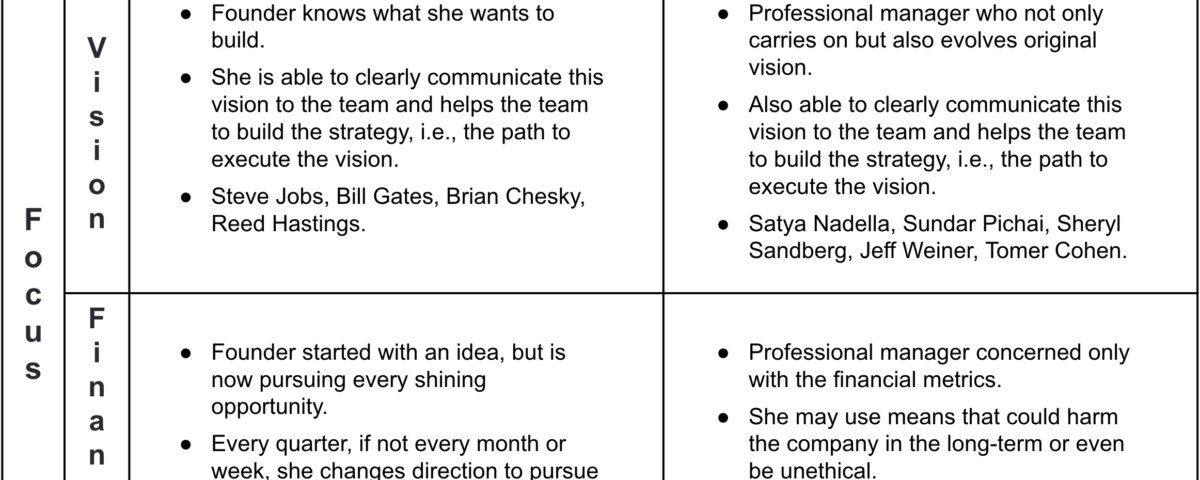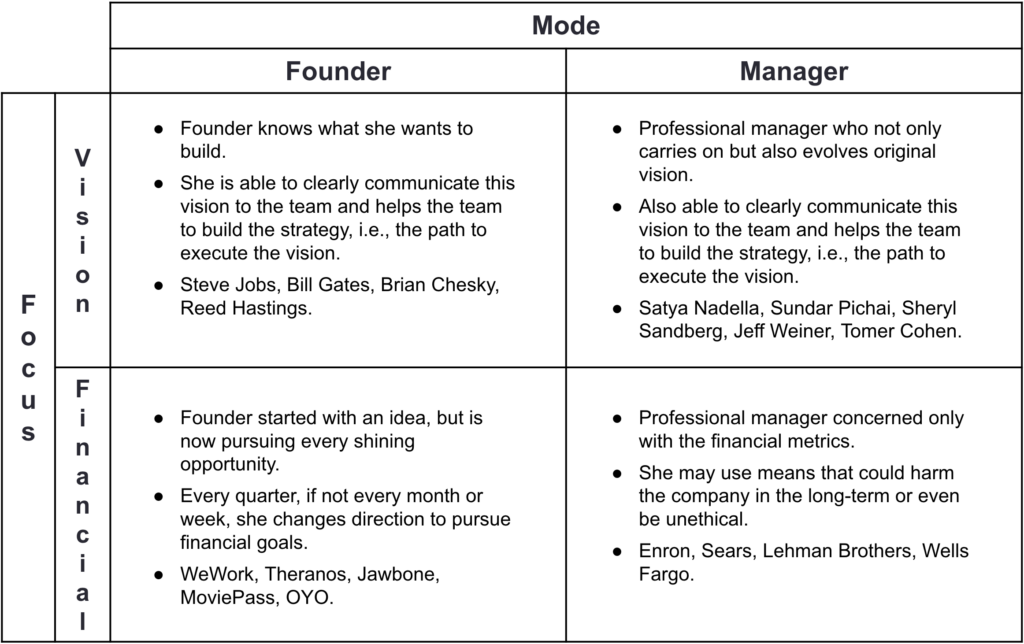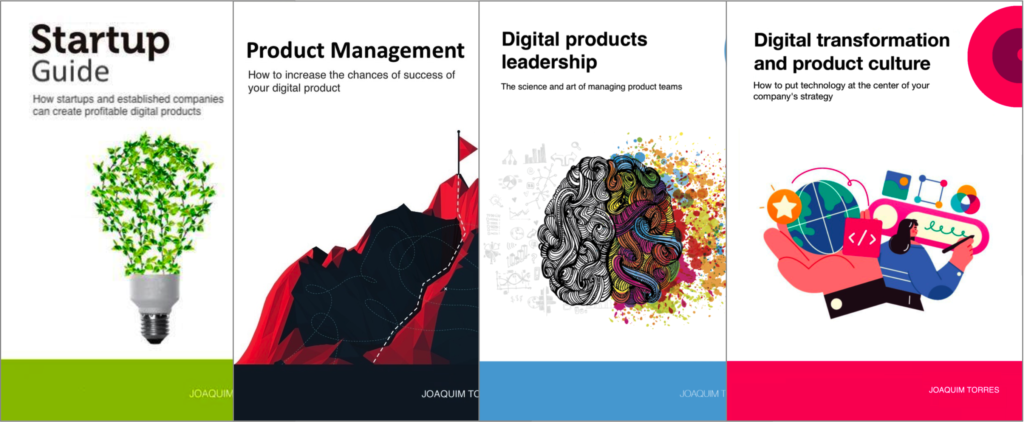
Case study: Centauro
2 de September, 2024
Ecosystem Mindset
17 de September, 2024Paul Graham, YCombinator’s co-founder, wrote about a talk that Brian Chesky, AirBnb’s co-founder, gave at a recent YC event for founders. Brian shared some of his learnings in scaling AirBnb in his talk and that he was advised to “hire good people and give them room to do their jobs.” He said that he followed this advice, and the results were disastrous. It seems this had happened to all the founders that were present at the event. After disastrous results, Brian decided to go back to being more involved in the details of what people in his company were doing.
According to Paul Graham, this is a distinct approach where founders are more directly involved in their companies than traditional managers. Key aspects of founder mode include:
- Direct Involvement: Founders engage with different levels of the organization, often bypassing the standard hierarchy and interacting directly with various teams and employees.
- Hands-On Approach: Unlike manager mode, which emphasizes delegation and autonomy for direct reports, founder mode allows founders to be more engaged in the details, often breaking the traditional rule that CEOs should manage only through their direct reports.
- Adaptability: Founder mode is not rigid; it allows founders to adjust how much they delegate based on their company’s specific needs and their trust in their managers. This approach is flexible and often changes as the company evolves.
- Contrarian to Conventional Wisdom: It challenges the idea that founders must step back as companies grow, showing that active, involved leadership can be more effective, even in larger companies.
Overall, founder mode leverages the founder’s unique perspective and drive, often feeling more intuitive and effective for founders than the more detached style typical of professional managers.
I strongly agree that the founders must get involved in the company’s details to help it grow. The founder had the original vision of what she wanted to build. What is the problem she wants to solve, and is the solution hypothesis she has to solve this problem? She needs to get involved in creating and testing the many solution hypotheses, and once a solution is found, she needs to work with the team on how to make this solution evolve and serve more people.
However, when Paul Graham talks about getting involved in the details, he warns about the risk of the founder not delegating and this becoming a huge obstacle to company growth:
Obviously founders can’t keep running a 2000 person company the way they ran it when it had 20. There’s going to have to be some amount of delegation.
Founders who are unable to delegate even things they should will use founder mode as the excuse.
Source: Founder Mode
In the article, Paul mentioned Steve Jobs as a great example of Founder Mode, citing how Steve used to skip levels to get into the details of how things were built. Curiously, Steve Jobs is also credited for the phrase:
It doesn’t make sense to hire smart people and tell them what to do; we hire smart people so they can tell us what to do.
Was Steve Jobs contradictory? Was he saying one thing (hire smart people and let them do their job) and doing another (skipping levels to enter into the details)?
I founded Dialdata, one of the first internet services providers in Brazil, in 1992, and I’m now back to being a founder of Gyaco, my consulting services company. In the meantime, I worked in companies in Founder mode as well as in Manager mode:
- VIA NET.WORKS: the company that acquired Dialdata had a clear plan to acquire ISPs to create a global internet service provider and eventually make an IPO. No long-term vision other than the financial goal. No wonder the company doesn’t exist anymore. There was not much concern about the product, only that we should have a standard product portfolio from the acquired companies so we can present ourselves to the stock market as a single company.
- .comDominio: after leaving VIA NET.WORKS I joined .comDominio, a data center company led by professional managers. The focus was to acquire companies to create a big internet services provider. No wonder also the company doesn’t exist anymore and it’s quite hard to find any news about this company.
- Locaweb: the leader in internet services in Brazil. When I joined the company, it was a web hosting company. Gilberto Mautner, one of the founders of the company, had a clear vision that Locaweb should help businesses to emerge and thrive through technology. That’s what originated the portfolio diversification strategy that led company to have more than 25 years old and more than 2.5B BRL in company valuation. I was fortunate enough to work together with Gilberto between 2005 and 2016. and help the company execute its vision. Gilberto frequently jumped into details of the execution. Given his technical background, even code implementation was a topic he discussed with the teams. Always with the purpose of helping businesses to emerge and thrive through technology as the context.
- ContaAzul: the leader in ERP for small businesses in Brazil, founded in 2011. They had a clear vision to boost small entrepreneurs’ success by bringing to small businesses more organization, control and time through technology. I joined the company in 2016 and in my role of CPO I was able to help Vincius Roveda and the other founders to make the vision more clear to the whole company and the market, to a point that the vision helped us secure a 30M USD series D round back in 2018. Founders close to the business, discussing details of important implementation and with a clear vision of what they were building was essential, and now Conta Azul has more 100K clients.
- Gympass/Welhub: a corporate benefit that companies offer to their employees so they can access to a networks of gyms and wellness apps. I joined the company in 2018 by an invitation of Cesar Carvalho, one of its founders. He had a clear vision to where he wanted to take his company. He wanted to defeat inactivity and was finding ways to do so. Initially it was gym passes that anyone could acquire in their website and eventually became the corporate benefit HRs hire to offer to their employees. When we were able to make clear what our vision was and even the opportunities to expand beyond workout, into wellness, this helped Gympass raise 300M USD in its series C. Even becoming an unicorn, Cesar continued to get involved in critical details to guarantee the vision was executed as he envisioned it.
- Lopes: the biggest real estate company in Latin America, the company is publicly traded since 2005, but it’s led by Lopes family since it foundation in 1935. I had the opportunity to work closely with Marcos and Francisco Lopes, the founder’s grandchildren, and it was clear how important it is to have the founder’s vision clear during all important decisions the teams need to make. I helped them make clear the tri-match vision, I..e., that Lopes helps people find their place, connecting them to the most suitable property through the best broker. Tri-match, the ideal meeting between client, property and broker. This clear vision helped guide Lopes digital transformation efforts.
Expanding the “founder mode” concept
After more than 30 years either as a founder or close to founders and professional managers, I noticed some intrinsic elements of each operation mode that may be useful to expand the “founder mode” concept introduced by Paul Graham.
He was right on point when he detected and named the founder mode, but he’s definition can be expanded to include an important aspect to the leadership mode concept: focus. Things will go wrong if the leader has the wrong focus, whether a founder or a professional manager. We need to consider the leader’s focus, whether she is focused on a long-term vision and how to execute this vision or on short-term financial metrics and how to improve those financial metrics.
We can have founders who envision where they want to get while other founders pursue financial targets. On the other side, we can have professional managers who not only carry on but also evolve the company vision and professional managers who are only focused on short-tem metrics.
Adding this new aspect, here are the four modes of operation:
- Founder mode with vision focus: Founder knows what she wants to build. She can communicate this vision to the team clearly and help the team build the strategy and the path to get there. Examples: Steve Jobs, Bill Gates, Brian Chesky, Reed Hastings.
- Founder mode with financial focus: Founder started with an idea but is now pursuing every shining opportunity. She changes direction every quarter if not every month or week to pursue financial goals. Examples: WeWork, Theranos, Jawbone, MoviePass, OyO.
- Professional manager with vision focus: Professional manager who not only carries on but also evolves original vision. She can also communicate this vision to the team clearly and help the team build the strategy and the path to get there. Examples: Satya Nadella, Sundar Pichai, Sheryl Sandberg, Jeff Weiner, Tomer Cohen.
- Professional manager with financial focus: Professional manager concerned only with the financial metrics. She may use means that could harm the company long-term or even be unethical. Examples: Enron, Sears, Lehman Brothers, Wells Fargo.
Using a 2×2 matrix, here it is:
Other interesting examples are Lisa Su at AMD, who revitalized the company with a clear technological vision to face competition from Intel and NVidia, and Mary Barra at GM, leading the transition to electric vehicles. These examples show how professional managers can evolve the company vision in transformative ways.
Some important considerations about the mode of operation and focus analysis above are:
- Connection Between Vision and Sustainability: one key observation is that founders and managers who focus on vision often lead companies that last longer and are more resilient. This highlights that a clear, long-term vision can drive sustainable business growth, whereas a purely financial focus may lead to short-term gains but long-term instability.
- Short-term vs long-term: one common concern of many, if not all, startups is how we manage to survive and earn the money we need to be here tomorrow and be able to execute our long-term vision. Well, nobody said it was easy, but some companies were able to survive this dilemma. Google, Microsoft, Apple, Netflix, and Airbnb are good examples. In Brazil, we have Lopes, Locaweb, Conta Azul, Gympass, iFood, Nubank. Examples we can learn from.
- Risks of Extreme Financial Focus: Being too focused on short-term financial metrics can be quite risky. Not only does it drive short-term decision-making, but it also undermines team trust, erodes customer loyalty, and often cultivates toxic cultures that can be detrimental in the long run. It may even lead to dangerous and unethical behaviors.
- Impact of Vision Communication: It is critical to clearly communicate the vision—not just as a strategic direction but as a tool for motivation and cultural alignment within the company. A strong vision acts as a north star, guiding teams through challenges and keeping them focused on long-term goals. The vision – where we want to get – and the strategy – how we get there – must be clearly communicated and constantly reminded so everyone is aligned and rowing in the same direction.
- Challenges of Founder Mode: even though a founder should get involved in details, this is no excuse not to delegate. As Steve Jobs said, we hire smart people so they can tell us what to do. The way Paul Graham described Founder mode may cause many founders to go into more and more detail with the team, which is not scalable. The correct way to scale is to set a clear vision and communicate it so everyone is aligned and the smart people we hire help us execute the vision. As Jeff Bezos said, “You need to be stubborn on your vision, but very flexible on the details.”
Defining Founder Mode
Here’s a proposed definition of Founder Mode, expanded from Paul Graham’s original article with concepts from Jeff Bezos and Steve Jobs:
Founder mode is a leadership operating model in which the founder sets and clearly communicates a vision—defining what the team is building, for whom, and why—so that the entire company is aligned and understands its purpose. In this mode, the founder’s role is to bring smart people onto the team who can help bring the vision to life. The founder can and should engage with the team on key details critical to building and realizing the vision.
I hope this definition sheds some light on Founder Mode and that this article demonstrates that anyone, whether a founder or a professional manager, can adopt this way of operating. By aligning your team around a clear and inspiring vision and getting involved in the details when necessary, you can ensure that what you build always aligns with that vision, significantly increasing your company’s chances of long-term success.
If you are not a founder but are a product lead working closely with a founder, your role is critical in helping to make the vision clearer for the team. Often, the founder has a clear vision of where she wants to go but may have difficulty communicating that vision to the team. This leaves her to get into the implementation details to ensure everything is aligned with her vision. As a product lead, you help translate that vision to everyone and ensure the team is united in building that direction.
Helping to create the vision
Throughout my career, I have worked helping companies, founders, and product heads to create their visions and product strategies, both in my own company and in leadership positions (Locaweb, Conta Azul, Gympass, and Lopes). Today, I do this through consulting and training, serving publicly and in-company (Itaú, Ambev Tech, among many others).
If you are a founder or product head and believe I can help you create your vision and strategy, get in touch by email or WhatsApp. Let’s talk and find the best way to work together!
Workshops, coaching, and advisory services
I’ve been helping companies and their leaders (CPOs, heads of product, CTOs, CEOs, tech founders, and heads of digital transformation) bridge the gap between business and technology through workshops, coaching, and advisory services on product management and digital transformation.
Digital Product Management Books
Do you work with digital products? Do you want to know more about managing a digital product to increase its chances of success, solve its user’s problems, and achieve the company objectives? Check out my Digital Product Management books, where I share what I learned during my 30+ years of experience in creating and managing digital products:
- Digital transformation and product culture: How to put technology at the center of your company’s strategy
- Leading Product Development: The art and science of managing product teams
- Product Management: How to increase the chances of success of your digital product
- Startup Guide: How startups and established companies can create profitable digital products



